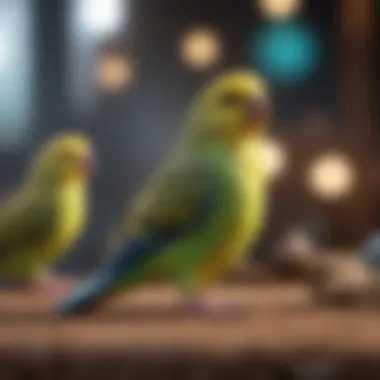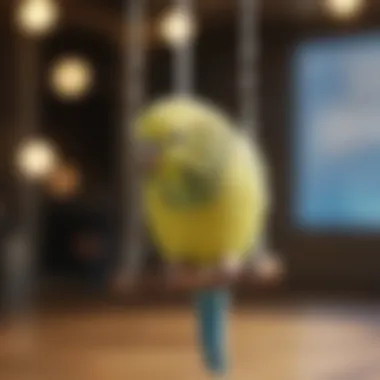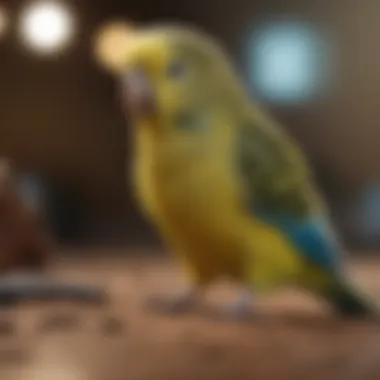Essential Guide to the Best Toys for Budgies


Intro
Toys are a crucial aspect of your budgie's life. They serve not just for entertainment but are essential for the bird's mental and physical health. Budgies, with their social nature, thrive when engaged in activities that stimulate their instincts and behaviors. This guide aims to inform you about the best toys for budgies, the types that suit their needs, and how to safely introduce these play items into their environment.
Understanding Your Pet
Pet Behavior Basics
Understanding typical budgie behavior helps in better toy selection. Budgies are active creatures that require stimulation. They often engage in climbing, vocalizing, and exploring. Toys should mimic these natural behaviors, promoting engagement and exercise. A common sign of boredom is over-preening or excessive quietness, indicating a need for new activities.
Common Breed Characteristics
While all budgies share certain traits, individual personalities may vary. Some budgies are more playful, while others may prefer solitary exploration. Knowing these traits helps in selecting toys that cater to their preferences. For instance, a playful budgie may enjoy swinging toys, while a more reserved one might appreciate puzzle toys that challenge their intellect.
Species-Specific Needs
Budgies need toys that reflect their unique instincts. They are naturally inclined to chew and explore. Therefore, selecting toys made from safe, non-toxic materials is essential. Many toys come with bells, strings, or surfaces that encourage pecking and chewing. These features not only amuse the birds but also fulfill their instinctual needs.
Choosing the Right Toys
Selecting the right toys involves understanding the types available. Consider toys that are visually appealing and safe. Additionally, look for varying textures and movements to keep things interesting. Here are some categories to consider:
- Chew Toys: Budgies enjoy chewing on safe wood or natural fibers. These promote beak health.
- Interactive Toys: Toys that require manipulation can boost mental stimulation.
- Swinging Toys: These promote physical activity and mimic natural swinging movements.
It's important to rotate toys regularly to keep your budgie engaged. New items can spark interest and prevent boredom.
Safety Considerations
When introducing toys, prioritize safety. Always avoid toys with small parts that can be swallowed or those made with harmful substances. Regularly inspect the toys for wear and tear. If you notice any damage, discard the toy immediately.
Remember to provide supervision while your budgie interacts with new toys, especially if they are trying them for the first time.
End
Understanding your budgie and its behavior is key to choosing appropriate toys. Consider the type, materials, and safety features of each toy. Provide a stimulating environment that accommodates their natural instincts. This will lead to not only a happy budgie but also a richer bond between you and your pet.
Prologue to Budgies and Their Needs
Budgies, also known as budgerigars, are small, intelligent parrots. They are popular pets due to their colorful feathers, playful behavior, and ability to mimic sounds. Understanding their needs is essential for pet owners interested in providing a fulfilling environment. This section delves into key elements that define budgie care, especially regarding toys, which play a vital role in their wellbeing.
Understanding Budgie Behavior
Budgies are social creatures. In their natural habitat, they live in flocks. Hence, they crave interaction and stimulation. A budgie can express itself through various behaviors, including chirping, preening, and exploring territory. Recognizing these behaviors is crucial for owners. For instance, when a budgie plays, it may indicate contentment. Furthermore, boredom can lead to destructive habits or stress. Providing appropriate toys can help mitigate such issues, allowing the budgie to explore its instincts safely.
Role of Toys in Budgie Wellbeing
Toys are more than just entertainment. They are essential for promoting physical activity and mental health. Engaging with toys mimics natural behaviors such as foraging, chewing, or climbing. As a result, toys help prevent obesity and boredom, leading to a healthier pet. Here are some key functions toys serve:
- Mental Stimulation: Toys encourage problem-solving skills. Budgies need to explore and manipulate their environment, keeping their minds active.
- Physical Activity: Swinging, climbing, and chewing are natural behaviors for budgies. Toys facilitate these activities, keeping them physically fit.
- Reducing Stress: Familiar toys can provide comfort, reducing anxiety during routine changes, such as moving homes or changes in daily schedules.
Criteria for Selecting Budgie Toys
Choosing toys for your budgie is not just a matter of preference. It is essential to consider several factors that contribute to your pet's health and happiness. Selecting the right toys ensures that they engage in play that stimulates their minds and bodies. Appropriate toys can enhance their quality of life significantly.


Material Safety
When selecting toys for budgies, material safety is a primary concern. Budgies are naturally curious animals and often chew on objects they find. Therefore, it is imperative to choose toys made from non-toxic materials. Look for toys that are labeled as pet-safe. Wooden toys are a popular choice, but ensure they are untreated and free from harmful chemicals. Avoid toys that contain small parts, as these can be a choking hazard or lead to injury. Always inspect the toys for sharp edges or components that could harm your bird. An excellent way to ensure safety is to opt for brands that specialize in bird toys.
Size Appropriateness
The size of the toys must align with the size of your budgie. Toys that are too small may pose a choking risk, while those that are too large can be difficult to use. Measure your bird briefly and compare its size to the dimensions provided on toy packaging. A good rule of thumb is to provide toys that your budgie can manipulate comfortably. Swinging and perch toys should be easily accessible, allowing your pet to hop on and off with ease. Knowing your budgie's preferences regarding size can enhance its play experience.
Durability Considerations
Durability also plays a vital role in selecting toys for budgies. Birds tend to be energetic, and their toys should withstand their playful behavior. Choose toys that are built to last, as flimsy ones can end up being a waste of money and resources. Look for signs of high-quality craftsmanship in the toys. For example, toys made from solid wood or thick plastic tend to be more durable. Regularly check toys for wear and tear, replacing them as necessary to ensure your budgie's safety and ongoing enjoyment. A durable toy not only stands the test of time but can also provide continuous stimulation for your bird.
"Selecting toys for your budgie is crucial to fostering their well-being and happiness. Prioritize safety, size, and durability to enhance their play experience."
By adhering to these criteria, you will create an enriching environment for your budgie that promotes playfulness and minimizes risks.
Types of Toys for Budgies
Understanding the various types of toys for budgies is essential for maintaining their physical health and mental well-being. Budgies are naturally active creatures. They need a range of stimulating toys to keep them engaged and happy. Each toy type offers distinct benefits and serves a purpose that can greatly enhance the quality of life for budgies. Here, we will explore five primary categories of toys that cater to their instincts and preferences.
Chew Toys
Chew toys are vital for budgies. They satisfy the budgie's natural instinct to nibble and chew. A robust chewing activity helps keep their beaks healthy. Furthermore, it alleviates boredom, which can lead to stress or destructive behavior. Popular materials include wood and natural fibers. Toys such as untreated wooden blocks or simple paper rolls can be ideal. You should ensure that the toys are free of toxic substances, as safety is paramount.
Foraging Toys
Foraging toys mimic the challenges budgies encounter in the wild, where they must search and use their intelligence to obtain food. Filling these toys with seeds or treats encourages natural foraging behavior. This engages their minds, promoting mental stimulation while providing a sense of accomplishment. Examples include treat-dispensing balls or platforms that hide food.
Interactive Toys
Interactive toys are designed to enhance the bond between you and your budgie. These toys often require direct interaction. They may involve steps like pushing buttons or pulling levers. Birds find these toys appealing, as they challenge their cognitive abilities. Engaging in playtime not only boosts their confidence but also strengthens the relationship with their owner. Consider toys that respond to your budgies’ actions, like sound-activated devices.
Swing and Perch Toys
Swing and perch toys provide birds with a place to rest while also promoting exercise. Budgies enjoy swinging back and forth. This movement mimics their natural behaviors. Installing a variety of swings and perches in their cage can motivate your budgie to fly and explore. Ensure that the swings are securely attached and made from safe materials to prevent any accidents. It might be beneficial to check the stability before each use.
Noise-Making Toys
Noise-making toys cater to the vocal nature of budgies. They stimulate their social instincts and encourage communication among them. Bells, rattles, or toys that make sounds when moved can excite your budgie. However, be cautious in selecting these types, ensuring that they are not overly noisy. Excessive noise can be stressful both for the birds and their human companions.
Selecting the right type of toy is crucial. Each type serves to foster play, promote exercise, and support mental health, making them indispensable in any budgie’s environment.
Top Recommended Toys for Budgies
When discussing toys for budgies, it is essential to focus on those that are highly recommended by experts and pet owners alike. These toys play a critical role in enhancing the overall well-being of budgies. They provide mental stimulation and promote physical activity, which is crucial for a bird's health. In addition, the right toys help satisfy natural instincts, such as chewing and foraging, which are important for maintaining a budgie's mental health.
Three key factors influence the recommendation of toys: popularity among budgie owners, expert reviews, and the suitability for various behaviors. The toys discussed here will cover a range of options tailored for different needs and preferences, ensuring a well-rounded selection for any budgie owner.
Best Chew Toys
Chew toys are an essential part of any budgie's playtime. Budgies naturally chew and gnaw, which helps maintain their beak health. Look for chew toys made from safe materials, such as untreated wood or paper. Some popular choices include:
- Palm Leaf Chew Balls: These are attractive and engaging. Their texture is great for chewing and helps prevent boredom.
- Wooden Chew Blocks: Solid and durable, these blocks encourage natural chewing behavior.
- Hemp Rope Toys: These satisfy chewing instincts while being resistant to wear and tear.
Each option serves a different purpose, but they all contribute to keeping the budgie engaged and satisfied.


Best Foraging Toys
Foraging toys stimulate a budgie's natural hunting behavior, encouraging them to explore and work for their food. This activity is critical for mental stimulation. Recommended options include:
- Foraging Wheels: These are fun and fillable with treats, sparking interest and curiosity as the budgie learns to access the rewards.
- Puzzle Feeders: Designed to challenge the bird, these feeders encourage exploration and problem-solving.
- Hide-and-Seek Toys: These allow birds to discover goodies hidden inside various compartments, fostering a sense of achievement.
Incorporating these toys into daily routines ensures that budgies remain mentally engaged.
Best Interactive Toys
Interactive toys promote bonding between the pet and its owner. These toys often involve elements that respond to the bird's actions. Notable examples include:
- Bird-Safe Mirrors: These can provide entertainment and engagement, making the budgie curious about its reflection.
- Interactive Electronic Toys: These are designed to attract attention and invite play when touched or manipulated.
- Remote-Controlled Toys: These allow the owner to control movement and captivate the bird's curiosity.
Interactive toys can enrich a budgie's environment and create opportunities for interaction.
Best Swing and Perch Toys
Swing and perch toys enhance physical activity while providing a resting spot. Budgies enjoy perching and swinging; these toys can make their habitat more dynamic. Some great options are:
- Wooden Swings: Made from natural materials, these swings are safe for chewing while providing a fun play area.
- Rope Perches: They offer a comfortable gripping surface, allowing the budgie to exercise its feet and legs while enjoying various positions.
- Multilevel Perches: These provide different heights for play and rest, encouraging movement throughout the cage.
Having multiple styles creates a habitat that stimulates flight and play.
Best Noise-Making Toys
Noise-making toys can provide auditory stimulation, mimicking the sounds they would experience in the wild. Budgies are social and often respond to sounds. Recommended toys include:
- Bell Toys: They produce sounds that intrigue budgies and invite interaction.
- Musical Toys: Those that play tunes when activated can be particularly engaging.
- Toys with Crinkly Materials: These add texture and sound, encouraging the bird to explore further.
Including noise-making toys not only entertains the birds but also contributes to their social behavior.
In summary, selecting the right toys for budgies involves careful consideration of their natural behaviors, preferences, and safety. A well-chosen selection promotes health and happiness in your pet.
How to Introduce Toys to Your Budgie
Introducing toys to your budgie is a critical step in enriching their environment. Budgies are intelligent creatures that require stimulation for their mental and physical health. Proper introduction of toys can prevent stress and encourage exploration, enhancing their overall well-being. Failing to introduce toys correctly might result in confusion or fear. This section will outline effective strategies for doing so and the significance of observing your budgie's reactions during this process.
Gradual Prolusion Techniques
When introducing a new toy to your budgie, a gradual approach is advisable. Sudden changes in their environment can be overwhelming. Start by placing the toy in their cage without drawing attention to it. This allows your budgie to investigate at their own pace. After a day or two, encourage interaction by gently pointing to the toy or even demonstrating how to use it. If it's a swing or a perch toy, try to show your budgie how to perch on it or use it for play. This method will help create a positive association with the toy.
Here are some techniques to make the introduction smoother:
- Start Small: Begin with one toy to gauge your budgie's initial interest.
- Use Positive Reinforcement: Offer treats or praises when your budgie interacts with the new toy.
- Switch Toys Frequently: Rotate toys every few days to maintain interest and engage different behaviors.
Monitoring Initial Reactions
Observation is key during the early stages of introducing any new toy. Not only does this help in understanding your budgie's preferences, but it also ensures that the toy is safe and well-accepted. Look for signs of curiosity, such as approaching the toy or playing with it. Conversely, if your budgie shows signs of distress—such as backing away, vocalizing excessively, or flapping their wings—it is essential to remove the toy and try again later.
Monitoring initial reactions involves:
- Taking Notes: Document your budgie's behavior with each new toy to identify likes and dislikes.
- Setting Time Limits: Initially limit exposure time with new toys to avoid overwhelming them.
- Creating Variables: Introduce toys in a quiet environment to minimize distractions, allowing your budgie to focus on the new item.


Effective introduction reduces the likelihood of your budgie developing fear or avoidance behaviors toward toys. Gradual exposure can lead to a confident and playful pet.
Maintaining and Cleaning Toys
Maintaining and cleaning toys for budgies is essential for several reasons. First, cleanliness is vital for preventing the buildup of bacteria and dirt. Budgies are naturally curious creatures that explore their environment using their beaks and feet. Toys that are not cleaned properly can harbor harmful pathogens.
Moreover, regular maintenance can prolong the lifespan of the toys. Budgie toys are often subjected to chewing, pulling, and other activities that may wear them down. Paying attention to maintenance can ensure that these toys remain safe and enjoyable for your pet.
Incorporating clean and well-maintained toys into your budgie's environment contributes to their physical and mental well-being. Clean toys are also more likely to engage a budgie's interest, promoting playfulness and exploration. Replacing old or damaged toys is also a part of overall maintenance.
Regular Maintenance Practices
Regular maintenance of toys is simple yet crucial. Here are some best practices:
- Visual Inspections: Make it a habit to visually inspect toys regularly. Check for signs of wear, such as frayed ropes or chipped wood.
- Rotate Toys: To keep your budgie engaged, rotate toys every few weeks. This helps maintain their interest and ensures that no single toy becomes overly worn.
- Remove Damaged Toys: If you notice any toys that have become damaged, remove them immediately. Sharp edges or broken pieces can pose risks.
Hygienic Cleaning Techniques
Cleaning budgie toys requires some specific techniques to ensure safety:
- Soaking in Warm Water: Soak toys in warm water mixed with a small amount of mild soap. Ensure the soap does not have fragrances or harsh chemicals.
- Scrubbing: Use a soft brush to gently scrub all surfaces of the toys. Pay special attention to crevices where dirt might accumulate.
- Rinse Thoroughly: It is crucial to rinse the toys under running water to remove any soap residue. Leftover soap can be harmful if ingested.
- Drying Properly: Allow toys to dry completely before returning them to the cage. Wet toys can promote mold growth, which is harmful to your budgie.
Proper maintenance and cleaning of budgie toys is not just about cleanliness; it's also about enhancing your pet's play experience.
By incorporating these practices, you can ensure that your budgie's toys remain a safe and enjoyable part of their habitat. Remaining vigilant about cleanliness and maintenance will greatly aid in the overall health and happiness of your budgie.
Safety Precautions with Budgie Toys
Ensuring safety is crucial when it comes to selecting and using toys for budgies. These small parrots are curious and adventurous but can be prone to injury or health issues if exposed to harmful materials or inadequate supervision. By focusing on safety precautions, owners can create an environment that is enjoyable and secure for their feathered friends. A careful approach to toy selection and usage will promote a positive playing experience while minimizing risks.
Avoiding Hazardous Materials
Budgie toys can be made from a variety of materials. It's imperative to identify those that are safe for budgies. Avoid toys made from plastics that may contain harmful chemicals, such as BPA and phthalates. Natural wood products are generally safer, but it’s essential to ensure they are untreated and free from toxins.
When choosing fabrics, look for options that are non-toxic and free from dyes and chemicals. Rope toys are popular, but monitoring for fraying or wear is important, as loose fibers can become a choking hazard. For a comprehensive selection, look for labels indicating non-toxic materials or certification from safety organizations. Also, be cautious with paint or finishes on any toy.
Some recommended safe materials include:
- Untreated natural wood
- Cotton rope
- Safe metals such as stainless steel
By actively avoiding hazardous materials, bird owners can protect their pets from potential harm.
Supervision During Play
Supervision during playtime is an essential safety measure. Budgies can be unpredictable, and having a watchful eye can prevent accidents and injuries. Pet owners should always be present when their budgies are interacting with toys. This allows for immediate intervention if the bird gets stuck, chews through a toy they shouldn’t, or shows signs of stress.
While observing playtime, pay attention to the budgie’s behavior. Look for signs of enjoyment, such as chirping or playful movements. If a budgie seems frightened or stressed, it might be time to reassess the toys offered or the overall environment.
"Regular interactions ensure that toys remain a positive part of your budgie's habitat."
Closure
The conclusion of this guide emphasizes the significance of choosing suitable toys for budgies. Toys are not merely luxuries for these birds; they are essential for their physical and mental well-being. Adequate play activities stimulate their natural behaviors, such as chewing, foraging, and exploring. When budgies engage with the right toys, they exhibit healthier habits, reduced stress levels, and enhanced social interactions.
Recapping the Importance of Suitable Toys
In essence, suitable toys contribute profoundly to the overall quality of life for budgies. These toys provide a platform for exercise, which can combat obesity—an issue seen in pet birds. Moreover, stimulating toys encourage problem-solving and mental engagement, nurturing intelligence and reducing boredom. Pet owners must recognize how the right selection of toys can lead to happier, healthier budgies.
Encouraging Continued Exploration
Encouraging ongoing exploration is another critical element. Budgies are naturally curious creatures. With the right toys, they can continue to learn and explore in safe environments. Regularly introducing new toys keeps their surroundings dynamic, promoting adventurous behaviors. It also helps to prevent the monotony that can lead to behavioral issues. Adaptability in toy selection is essential, ensuring that budgies’ interests are catered to over time.







